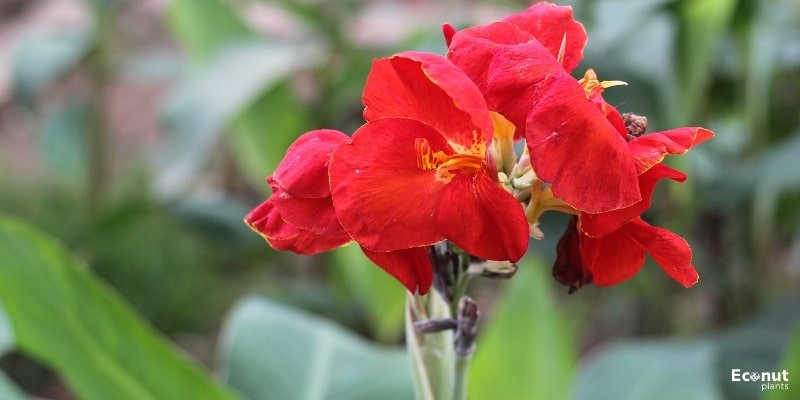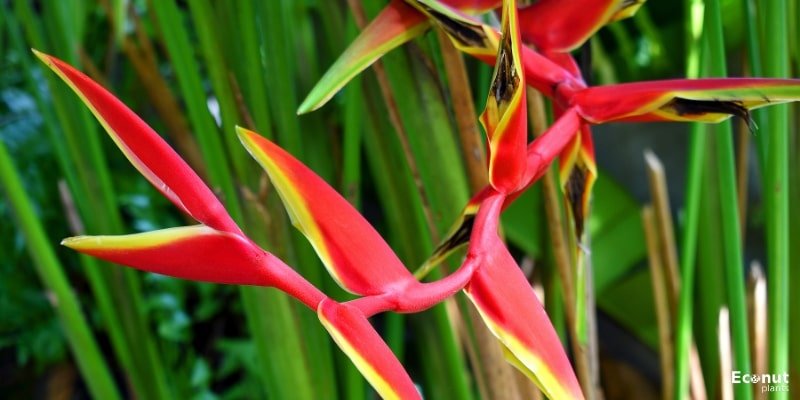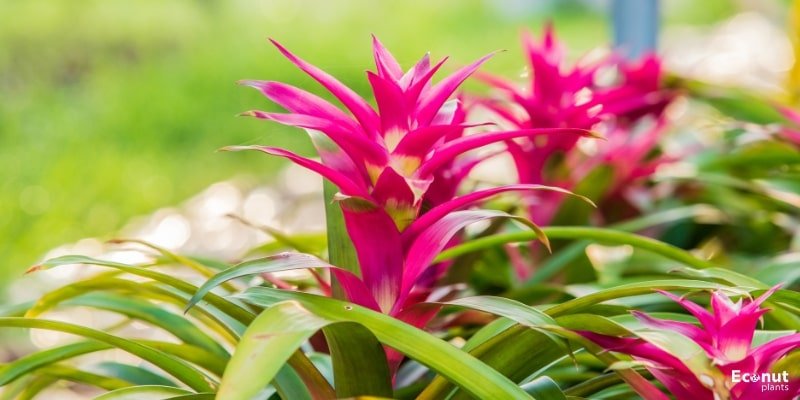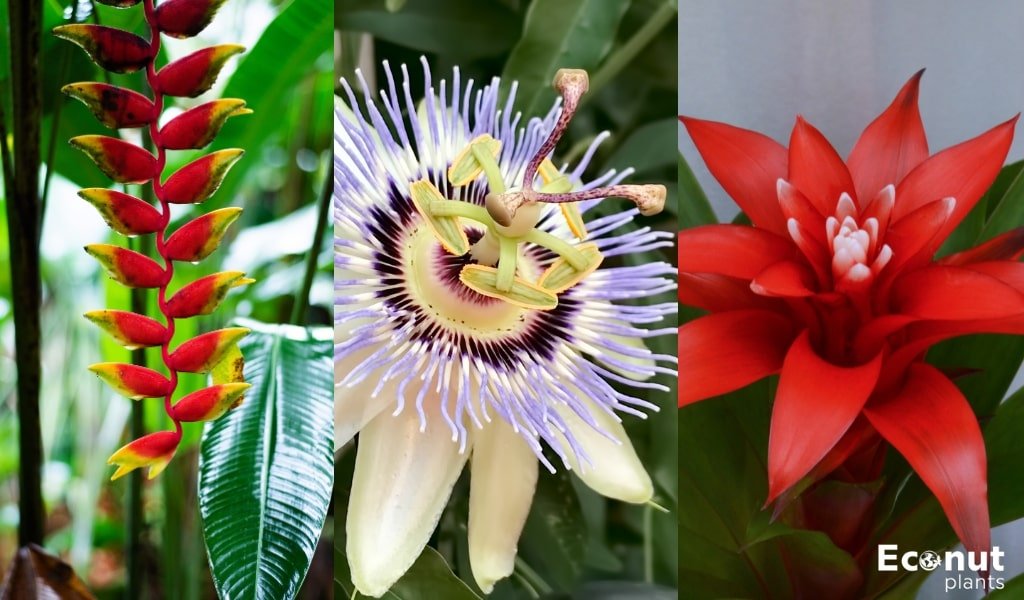Are you wondering what plants you can grow in your garden to create a tropical oasis if you live in a tropical or subtropical climate? Maybe all you want to do is discover some gorgeous tropicals to add to your collection of houseplants.
Here, gardening expert Melissa Strauss lists 17 tropical plant species that she loves, along with examples of some of their more well-known variants.
1. Canna Lily

Botanical Name: Canna
Sun Requirements: Full Sun
Season: Summer
Hardiness Zones: 9-10
In the garden, these knockouts make a bold statement. These relatives of the ginger and banana plants have few rivals with their huge, colourful foliage and exquisite blossoms.
There are numerous types with variegated foliage, and the leaves are long and resemble banana leaves. Rhizomes are the source of canna’s annual reproduction, which allows a small number of plants to grow into a large, vibrant cluster in a surprisingly short amount of time.
Shades of red, pink, yellow, coral, and white are available in canna blossoms, as well as mixtures of these hues. Though they don’t resemble lilies, Their blooms, which are finest in full light, are on tall stems. The Chou Chou cultivar yields gorgeous cream-coloured blooms with a peach-coloured throat and delicate peach freckles.
2. Ginger

Botanical Name: Zingiber officinale
Sun Requirements: Part Sun
Season: Fall
Hardiness Zones: 9-11
This native of Asia has established itself as a mainstay in many of the most notable food circles. Growing it as an edible makes this a remarkable plant because it has many health benefits as an ingredient. Rhizomes, the part of the plant that is edible, give rise to ginger plants. The tall, flat, ovate leaves have occasional variegation.
But ginger is more than simply an aid in the kitchen. Large, vibrant blossoms are produced by numerous ginger cultivars, which are also highly attractive.
The main characteristic of shampoo ginger, also called ‘Awapuhi kiwi, is its enormous red blooms that resemble pinecones and release a fragrant sap that may be used to wash hair.
3. Passion Vine

Botanical Name: Passiflora incarnata
Sun Requirements: Full Sun
Season: Spring – fall
Hardiness Zones: 7-10
A tropical blooming vine that thrives in tropical and subtropical regions, passionflower, also goes by the name “passion vine.” This perennial is resistant to roots up to zone 7. This vine is native to the Southeastern United States and provides food for wildlife as well as a host plant for butterflies.
The colours of passionflowers are pink, purple, blue, red, green, yellow, and white. With uniform petals and sepals surrounding a complicated pattern of stamens in the center, they have an exotic and big appearance. Cold-hardy to Zone 6, Incarnata Alba is a pure white flowering cultivar.
4. Travelers Palm

Botanical Name: Ravenala Madagascariensis
Sun Requirements: Full Sun
Season: Year-Round
Hardiness Zones: 10-11
The Traveller’s Palm isn’t even a real palm. Rather, it shares a cousin with birds-of-paradise and banana plants. When fully grown, it can reach a height of 30′, making it far larger than the bird of paradise. The leaves grow into enormous fan-like structures that resemble the tail of a peacock. Due to their great growth potential, these plants require a lot of room.
There are very interesting blossoms on this native Madagascar plant. Approximately five years after planting, the plant will bear creamy white blooms that resemble boats. These plants are incredibly nectar-producing, and lemurs pollinate them in their natural habitat!
5. Ornamental Banana

Botanical Name: Musaceae
Sun Requirements: Full Sun to Part Shade
Season: Year Round
Hardiness Zones: 7-10
Banana plants are typically thought of as trees. Though, they are the biggest herbaceous perennials. Certain types are planted purely for their aesthetic value, while others are cultivated for the tasty and healthy food they yield.
Flowers appear on banana plants before fruit or seed pods. These flowers are frequently very beautiful. They require protection from high winds that could harm their large leaves, and they prefer some shade. The Dwarf Cavendish is a widely used decorative banana that has lovely red colouring on its leaves and edible fruit.
6. Heliconia
![]()
Botanical Name: Heliconia
Sun Requirements: Part Shade
Season: Spring and Summer
Hardiness Zones: 10-11
The flowers of Heliconia, sometimes known as False Bird-of-Paradise, are similar to those of another genus. They are not connected, though.
Instead, their structural resemblance to the canna lily is greater, and they are related to the ginger and banana families. Tall, flat leaves with a tendency to spread make clusters of heliconia.
If you give them the right care, they will blossom all through the warm months. However, they do best in well-filtered light or light shade, and they like a little protection from the full sun.
7. Coral Vine

Botanical Name: Antigonon leptopus
Sun Requirements: Full Sun
Season: Late Summer – winter
Hardiness Zones: 9-11
Coral vinegar is known by several names. Some people refer to it as Queen’s Wreath, while others name it Mexican Creeper. Whatever name you give it, a tropical garden needs to have it. Thin, long vines branch out and have leaves that resemble hearts in a bright green colour. The vine itself is quite lovely, like a delicate grapevine.
Coral Vine is a breathtaking sight when it blooms. With clusters of the most exquisite, dainty pink blossoms covering it, this plant enjoys an extended blooming season. When it is in full bloom, it attracts a lot of pollinators and is a lovely location to view butterflies and bees.
8. Bougainvillea

Botanical Name: Bougainvillea
Sun Requirements: Full Sun
Season: Fall-Spring
Hardiness Zones: 9-11
A tropical shrubby vine that loves the sun, bougainvillea looks stunning when it is growing against a building or trellis. If you’re searching for a big plant with a lot of floral power, this is it.
For all its South American origin, this plant has a decidedly Mediterranean appearance. Colourful bracts, which resemble papery leaves, are the sections of the plant that are commonly thought of as flowers. Small, golden, tubular flowers are enclosed in bracts.
Orange, pink, white, yellow, purple, and red are among the colours of the bracts. Picking a favourite is tough because there are so many stunning types, but I have a soft spot for the Sundown orange variety because it was the backdrop for my wedding photos.
9. Laceleaf

Botanical Name: Anthurium
Sun Requirements: Bright Indirect Sunlight
Season: Year-Round Cycles
Hardiness Zones: 11-12
Laceleaf, often known as anthurium, is a wonderful houseplant. They can also be cultivated outside in warmer climates, and they look stunning in tropical landscaped gardens. With the right care, the glossy, leathery blossoms in shades of pink, white, and red can bloom all year.
Aside from being called laceleaf, anthuriums are also commonly called flamingo flowers because of their eye-catching look. The glossy leaves need strong light, but they need to be filtered or indirect to preserve their integrity. Many species are epiphytic—that is, they grow on other things, including trees.
10. Plumeria

Botanical Name: Plumeria
Sun Requirements: Full Sun
Season: Summer – fall
Hardiness Zones: 10-12
Plumeria, sometimes called Frangipani, is a little flowering tree with a lovely scent, and its most frequent blooms are used to make leis. These trees are stunning additions to any tropical or subtropical setting. Because plumeria blossoms are extremely fragrant, perfumers find them to be very popular. Numerous cosmetics, candles, and other home fragrance goods contain their scent.
They endure direct sun quite well and grow best in hot, sandy soil types. Plumerias are multicoloured plants with a wide variety of unique smells. A lovely variation with pinwheel-shaped pink, white, and yellow blooms is called “Riviera Rainbow.”
11. Angel’s Trumpet

Botanical Name: Brugmansia
Sun Requirements: Full Sun
Season: Summer
Hardiness Zones: 9-12
Brugmansia, often known as angel’s trumpet, is a gorgeous tropical plant that blooms at night. Being evergreen, it keeps its vivid green leaves throughout the year. This plant grows normally as a tiny tree, but in the correct circumstances, it can grow as high as thirty feet. The flowers are tall, trumpet-shaped, and come in white, pink, and yellow hues.
The evening bloom of brumbmansia releases a pleasant scent. Close to a patio or deck, where its fragrance and beauty can be appreciated, it makes a great plant. With a soft green interior, the “Cherub” cultivar has a gorgeous peach and cream colour. Since every part of the plant is dangerous, exercise caution while around small children and pets.
12. Mandevilla

Botanical Name: Mandevilla
Sun Requirements: Sun
Season: Spring – fall
Hardiness Zones: 9-11
The mandevilla is a colourful and adaptable tropical flowering plant. As long as it is taken inside for the winter, it can be successfully cultivated in lower climes because it is well adapted to container planting. It does well in both full and partial shade, showing less sensitivity to the sun’s rays. While some types tend to climb more, others are shrubbier.
Like most tropical plants, it thrives in warm, humid climates. If grown indoors, additional humidity will probably be needed. It can safely be fertilized every two weeks and is a heavy feeder. The Alice DuPont cultivar can reach a height of 20 feet and has stunning, deep pink blossoms.
13. Orchids

Botanical Name: Orchidaceae
Sun Requirements: Bright Filtered Light
Season: Varies
Hardiness Zones: 6-12 Varies
It is challenging to categorize orchids because there are so many fascinating genera and species. As houseplants, these largely epiphytic and primarily tropical-blooming plants have made their way into a very popular niche.
You can grow them outside on trees, just like they would in the wild if you are lucky enough to live in a tropical climate.
High humidity, bright, indirect sunshine, and enough air movement are among the requirements that orchids have. These will have to go inside the greenhouse because they can be hard to recreate in colder locations.
14. Bromeliad

Botanical Name: Bromeliaceae
Sun Requirements: Part Shade
Season: Year-Round
Hardiness Zones: 9-10
When they bloom and have lovely leaves all year round, bromeliads make excellent houseplants in non-tropical areas. The telescoping rosette of broad, pointed leaves resembles a palm. The size and coloration of the many species vary greatly; the smallest is a little more than an inch tall, while the largest reaches about three feet in height.
As epiphytes, these plants usually prefer light that is filtered through an overhanging canopy. Bromeliads don’t require any special care and are simple to maintain. A bromeliad usually produces a huge blossom just before it dies, when its life cycle is almost over. But fear not—they routinely send out offsets to take the place of the parent plant. Among the members of this genus that yield delicious fruit instead of flowers.
15. Prayer Plants

Botanical Name: Calathea
Sun Requirements: Medium to Bright Indirect Light
Season: Spring – Summer
Hardiness Zones: 11-12
Callatheas are commonly sold as houseplants since they prefer to grow in moderate settings and stay out of direct sunlight. However, they thrive under a canopy in an outdoor tropical habitat. Calathea also referred to as prayer plants, have the peculiar characteristic of raising their leaves at night and lowering them during the day to maximize their exposure to sunshine.
Calendula plants are happy when they bloom. As some gardeners prefer that the plant concentrate its efforts on developing leaves, removing the blooms will help conserve energy.
16. Protea

Botanical Name: Protea
Sun Requirements: Full Sun
Season: Spring – fall
Hardiness Zones: 8-11
The genus Protea has more than 1,000 species of tropical flowers. Their heights vary greatly, ranging from a little 3′ to a massive 26′. They prefer lots of sunlight, excellent air movement, and extremely well-draining soil. Tropical plants known as proteas may withstand some degree of cold. They are hardy in Zone 8 and able to withstand temperatures as low as 23°F.
The most famous feature of these plants is their blooms. These huge, complex blossoms are the envy of floral designers. Their blooming cycle is lengthy, with a big cluster of perianths and styles tipped with pollen first emerging in the shape of a cup.
17. Bird-of-Paradise

Botanical Name: Strelitzia
Sun Requirements: Bright Indirect Light
Season: Fall-Spring
Hardiness Zones: 10-12
The common name of this well-known shrub comes from the way its blossoms look. These vibrant blossoms in hues of yellow, orange, blue, and white mimic exotic birds. The genus is indigenous to Africa and is found in the tropical and subtropical climate zones of the Southeast. Although these plants prefer lots of light, excessive exposure to direct sunlight can scorch leaves.
These plants do best in tropical environments with a highly illuminated canopy. The best light comes from plants that are overhead. Bird-of-paradise plants require a lot of moisture and humidity when they are developing and flowering. The traditional S. reginae is the most prevalent species of Strelitzia. The brightest and most remarkable tropical flowers belong to this species.
Conclusion
Whether you want to find exotic houseplants or create an outdoor tropical landscape, all of these plants will contribute to that vacation vibe. You may still add a touch of the tropics to your house, even if you don’t reside in one.
These plants can be used to build your private tropical sanctuary if you are fortunate enough to dwell in this well-liked climate all year round!

